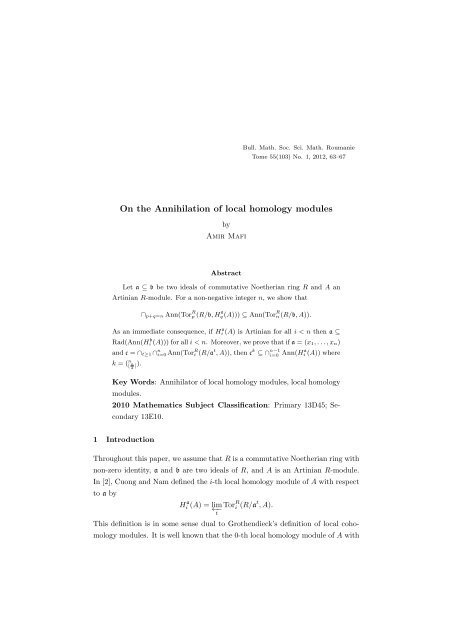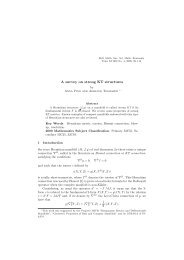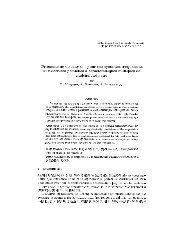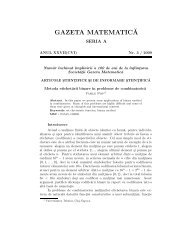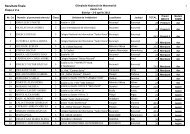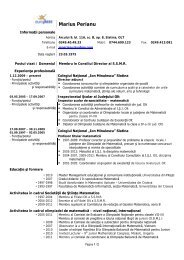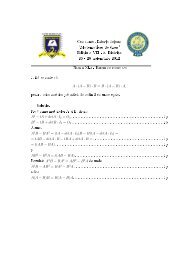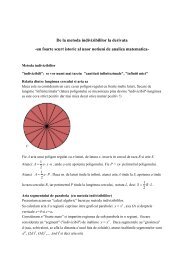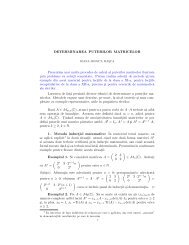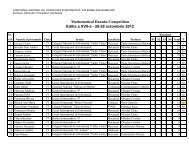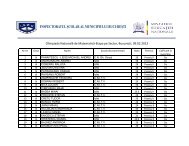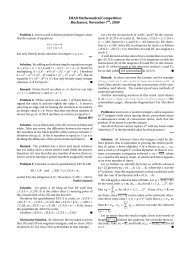On the Annihilation of local homology modules - SSMR
On the Annihilation of local homology modules - SSMR
On the Annihilation of local homology modules - SSMR
You also want an ePaper? Increase the reach of your titles
YUMPU automatically turns print PDFs into web optimized ePapers that Google loves.
Bull. Math. Soc. Sci. Math. RoumanieTome 55(103) No. 1, 2012, 63–67<strong>On</strong> <strong>the</strong> <strong>Annihilation</strong> <strong>of</strong> <strong>local</strong> <strong>homology</strong> <strong>modules</strong>byAmir MafiAbstractLet a ⊆ b be two ideals <strong>of</strong> commutative Noe<strong>the</strong>rian ring R and A anArtinian R-module. For a non-negative integer n, we show that⊓ p+q=n Ann(Tor R p (R/b, H a q (A))) ⊆ Ann(Tor R n (R/b, A)).As an immediate consequence, if H a i (A) is Artinian for all i < n <strong>the</strong>n a ⊆Rad(Ann(H b i (A))) for all i < n. Moreover, we prove that if a = (x 1, . . . , x n)and c = ∩ t≥1 ∩ n i=0 Ann(Tor R i (R/a t , A)), <strong>the</strong>n c k ⊆ ∩ n−1i=0 Ann(Ha i (A)) wherek = ( n [ n 2 ] ).Key Words: Annihilator <strong>of</strong> <strong>local</strong> <strong>homology</strong> <strong>modules</strong>, <strong>local</strong> <strong>homology</strong><strong>modules</strong>.2010 Ma<strong>the</strong>matics Subject Classification: Primary 13D45; Secondary13E10.1 IntroductionThroughout this paper, we assume that R is a commutative Noe<strong>the</strong>rian ring withnon-zero identity, a and b are two ideals <strong>of</strong> R, and A is an Artinian R-module.In [2], Cuong and Nam defined <strong>the</strong> i-th <strong>local</strong> <strong>homology</strong> module <strong>of</strong> A with respectto a byHi a (A) = lim Tor R ←−t i (R/a t , A).This definition is in some sense dual to Gro<strong>the</strong>ndieck’s definition <strong>of</strong> <strong>local</strong> co<strong>homology</strong><strong>modules</strong>. It is well known that <strong>the</strong> 0-th <strong>local</strong> <strong>homology</strong> module <strong>of</strong> A with
64 Amir Mafirespect to a, H a 0 (A), is always Artinian, simply because <strong>the</strong>re exists an integer tsuch that H a 0 (A) ∼ = A/a t A. But what about <strong>the</strong> following question: what is <strong>the</strong>largest integer n such that all <strong>the</strong> <strong>modules</strong> Hi a (A) are Artinian for all i < n? Thisquestion is dual to <strong>the</strong> question <strong>of</strong> which ideals annihilate <strong>the</strong> <strong>local</strong> co<strong>homology</strong><strong>modules</strong>, and <strong>the</strong> classical <strong>the</strong>orem on <strong>local</strong> co<strong>homology</strong> <strong>modules</strong> is Faltings’ AnnihilatorTheorem [4]. There are not many results concerning <strong>the</strong> finiteness <strong>of</strong><strong>local</strong> <strong>homology</strong> <strong>modules</strong>. In this regard, see [3], [6] and [7].In this paper, for each ideals a and b <strong>of</strong> R with a ⊆ b, we show a relationshipbetween <strong>the</strong> annihilators <strong>of</strong> <strong>the</strong> <strong>modules</strong> Tor R i (R/b, A) and Tor R i (R/b, H a j (A)).This provides a new characterization <strong>of</strong> <strong>the</strong> concept <strong>of</strong> A-coregular sequence <strong>of</strong> anarbitrary ideal <strong>of</strong> R. Also, we prove that if n is a non-negative integer such thatHi a(A) is Artinian for all i < n, <strong>the</strong>n a ⊆ Rad(Ann(Hb i (A))) for all i < n. Moreover,we show that if a = (x 1 , . . . , x n ) and c = ∩ t≥1 ∩ n i=0 Ann(TorR i (R/a t , A)),<strong>the</strong>n c k ⊆ ∩ n−1i=0 Ann(Ha i (A)) where k = (n [ n 2 ]).2 The resultsThe following <strong>the</strong>orem is dual <strong>of</strong> [5, Theorem 2.2].Theorem 2.1. Let a ⊆ b be two ideals <strong>of</strong> R, and n a non-negative integer. Then⊓ p+q=n Ann(Tor R p (R/b, H a q (A))) ⊆ Ann(Tor R n (R/b, A)).Pro<strong>of</strong>: Let us consider functors F (−) = R/b ⊗ R − and G(−) = H a 0 (−). Thefunctor F is obviously right exact and a projective module P implies H a 0 (P ) isflat by [1, 1.4.7] or [11, 2.4]. Combining [9, Theorem 11.39] with [11, Theorem1.1] yields a Gro<strong>the</strong>ndieck spectral sequenceE 2 p,q := Tor R p (R/b, H a q (A)) =⇒pTor R p+q(R/b, A).Thus, for each n ≥ 0, <strong>the</strong>re is a finite filtration <strong>of</strong> <strong>the</strong> module H n = Tor R n (R/a, A)0 = φ −1 H n ⊆ φ 0 H n ⊆ . . . ⊆ φ n−1 H n ⊆ φ n H n = H nsuch that E ∞ i,n−i ∼ = φ i H n /φ i−1 H n for all 0 ≤ i ≤ n (see [9, §11]). Since E ∞ i,n−iis a subquotient <strong>of</strong> E 2 i,n−i for all 0 ≤ i ≤ n, it implies that φi H n /φ i−1 H n isannihilated by Ann(Tor R i (R/b, Hn−i a (A))) for all 0 ≤ i ≤ n. Thus, we get that⊓ p+q=n Ann(Tor q p(R/b, Hq a (A)) annihilates <strong>the</strong> <strong>homology</strong> module Tor R n (R/b, A).This completes <strong>the</strong> pro<strong>of</strong>.
<strong>On</strong> <strong>the</strong> <strong>Annihilation</strong> <strong>of</strong> <strong>local</strong> <strong>homology</strong> <strong>modules</strong> 65A sequence <strong>of</strong> elements x 1 , . . . , x n in R is said to be an A-coregular sequence(see [8, Definition 3.1]) if 0 : A (x 1 , . . . , x n ) ≠ 0 andx0 : A (x 1 , . . . , x i−1 ) −→i0 :A (x 1 , . . . , x i−1 ) is surjective for i = 1, 2, . . . , n. Wedenote by width(a, A) <strong>the</strong> supremum <strong>of</strong> <strong>the</strong> lengths <strong>of</strong> all maximal A-coregularsequences in <strong>the</strong> ideal a.Corollary 2.2. Let a be an ideal <strong>of</strong> R such that 0 : A a ≠ 0. Then width(a, A) =inf{n : Tor R i (R/a, Hj a (A)) ≠ 0 for some non-negative integers i, j with i+j = n}.Pro<strong>of</strong>: We denote by B <strong>the</strong> set in <strong>the</strong> above equality. In view <strong>of</strong> [3, Theorem4.11] it follows that width(a, A) ≤ inf B. <strong>On</strong> <strong>the</strong> o<strong>the</strong>r hand, by Theorem 2.1 and[8, Theorem 3.9] we have inf B ≤ width(a, A). This finishes <strong>the</strong> pro<strong>of</strong>.Corollary 2.3. Let a ⊆ b be two ideals <strong>of</strong> R. Then, for each non-negative integern, ⊓ n i=0 Ann(Ha i (A)) ⊆ ∩ t≥1 ∩ n i=0 Ann(TorR i (R/b t , A)).Pro<strong>of</strong>: Let t be a positive integer. Then a t ⊆ b t . Hence, for each non-negativeinteger m, it follows from Theorem 2.1 and [2, Remark 2.1(ii)] that⊓ i+j=m Ann Tor R i (R/b t , Hj a(A)) ⊆ Ann(TorR m(R/b t , A)). Since <strong>the</strong> Tor functorsare linear, <strong>the</strong> result now follows.Theorem 2.4. Let a ⊆ b be two ideals <strong>of</strong> R, and n a non-negative integer suchthat Hi a(A) is Artinian for all i < n. Then a ⊆ Rad(Ann(Hb i (A))) for all i < n.Pro<strong>of</strong>: By [2, Proposition 4.7], <strong>the</strong>re exists a positive integer m such thata m Hi a(A) = 0 for all i < n. Put l := mn. Then al ⊆ ⊓ n−1i=0 Ann(Ha i (A)).Thus, by Corollary 2.3 a l ⊆ ∩ n−1i=0 Ann(TorR i (R/b t , A)) for all t ∈ N. Thereforea l Hi b(A) = 0 for all i < n and so a ⊆ Rad(Ann(Hb i (A))) for all i < n, as required.We prove <strong>the</strong> following <strong>the</strong>orem by similar techniques that used in [10, Theorem3].Theorem 2.5. Let n be a non-negative integer such that a = (x 1 , . . . , x n ). Ifc = ∩ t≥1 ∩ n i=0 Ann(TorR i (R/a t , A)), <strong>the</strong>n c k ⊆ ∩ n−1i=0 Ann(Ha i (A)) where k = (n [ n 2 ]).
66 Amir MafiPro<strong>of</strong>: First we show, for k ≤ n, that (c) (k i ) H i (x t 1, . . . , x t k; A) = 0, for 0 ≤ i < kand t ≥ 1. To this end we make an induction on k. If k = 1 and i = 0, <strong>the</strong>nH 0 (x t 1; A) ∼ = A/x t 1A is annihilated by c. Assume k ≥ 2. We show <strong>the</strong> statementby induction on i. For i = 0 we have <strong>the</strong> exact sequenceA/x t 1A −→ H 0 (x t 1, . . . , x t k; A) −→ 0and <strong>the</strong> assertion is true. For i ≥ 1 <strong>the</strong>re is a short exact sequence0 −→ H i (x t 1, . . . , x t k−1; A)/x t kH i (x t 1, . . . , x t k−1; A) −→ H i (x 1 , . . . , x t k; A)−→ (0 : Hi−1(x t 1 ,...,xt k−1 ;A) x t k) −→ 0,t ≥ 1. If i < k − 1, <strong>the</strong> induction hypo<strong>the</strong>sis yields <strong>the</strong> statement. In <strong>the</strong> casei = k − 1 we getH i (x t 1, . . . , x t k−1; A)/x t kH i (x t 1, . . . , x t k−1; A) ∼ = R/(x t 1, . . . , x t k)⊗(0 : A (x t 1, . . . , x t k−1)).Hence <strong>the</strong> short exact sequence proves <strong>the</strong> statement on <strong>the</strong> annihilation.In particular, we have (c) (k i ) H i (x t 1, . . . , x t k; A) = 0 (0 ≤ i < n, t ≥ 1).By [2, Theorem 3.6], we have Hi a (A) = limH ←− i (x t 1, . . . , x t n; A). Note thatt(c) (n i ) limH i (x t ←−t 1, . . . , x t n; A) ⊆ lim(c) (n i ) H i (x t ←−t 1, . . . , x t n; A) = 0. Therefore it follows(c) (n i ) Hi a (A) = 0, which proves <strong>the</strong> statement.Acknowledgement . The author is deeply grateful to <strong>the</strong> referee for carefullyreading <strong>of</strong> <strong>the</strong> original manuscript and <strong>the</strong> valuable suggestions. The author alsowould like to thank Dr. Hero Saremi for many helpful discussions during <strong>the</strong>preparation <strong>of</strong> this paper.References[1] J. Bartijn, Flatness, completions, regular sequences, un ménage à trois.Thesis, Utrecht, (1985).[2] N.T. Cuong and T. T. Nam, The I-adic completion and <strong>local</strong> <strong>homology</strong>for Artinian <strong>modules</strong>, Math. Proc. Camb. Phil. Soc., 131(2001), 61-72.[3] N.T. Cuong and T.T. Nam, A <strong>local</strong> <strong>homology</strong> <strong>the</strong>ory for lineary compact<strong>modules</strong>, J. Algebra, 319 (2008), 4712-4737.
<strong>On</strong> <strong>the</strong> <strong>Annihilation</strong> <strong>of</strong> <strong>local</strong> <strong>homology</strong> <strong>modules</strong> 67[4] G. Faltings, Uber die annulatoren lokaler kohomologiegruppen, Arch.Math., 30(5)(1978), 473-476.[5] K. Khashyarmanesh, <strong>On</strong> <strong>the</strong> annihilators <strong>of</strong> <strong>local</strong> co<strong>homology</strong> <strong>modules</strong>,Comm. Algebra, 37(2009), 1787-1792.[6] A. Mafi and H. Saremi, Coassociated primes <strong>of</strong> <strong>local</strong> <strong>homology</strong> and <strong>local</strong>co<strong>homology</strong> <strong>modules</strong>, Rocky Mountain J. Math., 41(5)(2011), 1631-1638.[7] A. Mafi and H. Saremi, <strong>On</strong> <strong>the</strong> finiteness <strong>of</strong> <strong>local</strong> <strong>homology</strong> <strong>modules</strong>,Rend. Semin. Mat. Univ. Politec. Torino, 67(2009), 115-122.[8] A. Ooishi, Matlis duality and <strong>the</strong> width <strong>of</strong> a module, Hiroshima Math. J.,6 (1976), 573-587.[9] J. Rotman, Introduction to homological algebra, (Academic Press, 1979).[10] P. Schenzel, Cohomological annihilators, Math. Proc. Camb. Phil. Soc.,91(1982), 345-350.[11] A. M. Simon, Some homological properties <strong>of</strong> complete <strong>modules</strong>, Math.Proc. Camb. Phil. Soc., 108(1990), 231-246.Received: 25.05.2010,Revised: 28.12.2010,Accepted: 10.12.2011.Department <strong>of</strong> Ma<strong>the</strong>matics,University <strong>of</strong> Kurdistan,Pasdaran St., P.O. Box: 416,Sanandaj, IranandSchool <strong>of</strong> Ma<strong>the</strong>matics,Institute for Researchin Fundamental Science (IPM),P.O. Box 19395-5746,Tehran, Iran.E-mail: a mafi@ipm.ir


